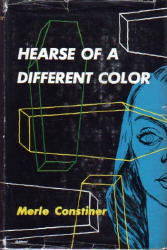Sun 26 Oct 2008
BOUCHER ON WOOLRICH: WHEN TITANS TOUCHED, Part III – by Francis M. Nevins.
Posted by Steve under Authors , Editors & Anthologies[4] Comments
WHEN TITANS TOUCHED
by Francis M. Nevins
Previously on this blog:
PART II. THE STORY COLLECTIONS.
Part III. LETTERS, A CARD AND A MEETING.
Boucher wrote Woolrich for the first time in the late spring of 1944, requesting permission to reprint a story in his anthology Great American Detective Stories (World, 1945). Replying on June 5, Woolrich recommended that Boucher use the 1938 “Endicott’s Girl,” which he called “my favorite among all the stories I’ve ever written.”

Boucher didn’t care for that one, as he explained in a July 19 letter to World editor William Targ: “It has in extreme measure the frequent Woolrich flaw – a fine emotional story which ends with loose ends all over the place and nothing really explained.”
Instead Boucher opted for “Finger of Doom” (1940), which he retitled “I Won’t Take a Minute.” The new title was retained when the story was included in The Ten Faces of Cornell Woolrich (1965). “Endicott’s Girl” remained uncollected until I put it in Night and Fear (2004).
On July 20, one day after his letter to Targ, Boucher wrote Woolrich again: “In the past month or two I’ve read over 30 [of your] pulp stories. And even from such a dose as that I still feel no indigestion; which means, I take it, that you are (as I have suspected all along) the goods. Keep ’em coming!”
Woolrich’s reply, dated July 23, solved a puzzle for me. I had long suspected that his “The Penny-a-Worder” (1958; first collected in Nightwebs, 1971), which is about a pulp writer who has to hack out a story overnight to go with an already completed front cover illustration, was based on personal experience.

After finding the July 23 letter among Boucher’s papers at the Lilly Library I knew it for a fact. In it Woolrich mentioned that he particularly remembers his story “Guns, Gentlemen” (1937; collected as “The Lamp of Memory” in Beyond the Night, 1959) “because I wrote it to match up with the cover of the magazine, which they sent me.” This doesn’t mean, of course, that he wrote the story in a single night!
On a file card dating from 1950 or early 1951, when he was co-editing The Magazine of Fantasy and Science Fiction, Boucher set down his reaction to the idea of reprinting Woolrich’s novella “Jane Brown’s Body” (1938). “This brilliantly macabre concept spoiled for me by 2 things: a.) My pet irritation of writing exclusively in present tense; b.) A pulp plot so formulaly obvious that each step can be accurately forecast. Inept, for Woolrich, but because of his name let’s include.”
It was reprinted in the magazine’s October 1951 issue and collected in The Fantastic Stories of Cornell Woolrich (1981).

Boucher finally met Woolrich while on a visit to New York in April 1965. He died without writing about the encounter but his widow, Phyllis White, was present and described it for me before her own death:
“[W]e were in a restaurant with some MWA members after a private viewing of a film…. Clayton Rawson [then managing editor of EQMM] told us that before going home he was going to drop in on Cornell Woolrich, who was convalescing from surgery, and he suggested that we come along.
“Of course Tony was thrilled at the prospect. We went to the hotel room where Woolrich was temporarily quartered. One eye had been operated on and he was to go back after an interval for an operation on the other. [Saint Mystery Magazine editor] Hans Santesson was there trying to look after him. He was supposed to go easy on drinking so he was sticking to wine. Santesson kept suggesting pleasantly but ineffectively that he slow down.
“The room had until recently been used for storage of furniture. It was in good enough condition except for lacerated wallpaper. Woolrich complained that the hotel staff was sneering and laughing at him behind his back. Rawson asked Woolrich whether he had anything lying around that would be suitable for reprint in EQMM.

“Woolrich rummaged around and turned up something. There was a bit of comic pantomime in which Rawson started to look at the story and then tried to hide it from rival editor Santesson peering over his shoulder.
“The only dramatic incident of the evening was missed by Rawson, who had to leave to catch his train. The door opened suddenly and a crowing man burst in with a girl and a bottle. The hotel had mistakenly sent him to that room and he was indignant on finding us there…
“The intruder withdrew, leaving Woolrich convinced that this was another part of the conspiracy against him. Eventually we left but it wasn’t easy. Woolrich thought that people who went away, no matter how long they had stayed, were leaving because they didn’t like him. Tony was delighted that he had finally met Woolrich, and at the same time thought that it wouldn’t do his own nerves any good to see too much of him… ”
He needn’t have worried. They never met again. Boucher died of lung cancer on April 29, 1968, at the unbearably early age of 56; Woolrich of a stroke on September 25, a little more than two months before his 65th birthday. Just a few months apart. Forty years ago this year. May they rest in peace.























